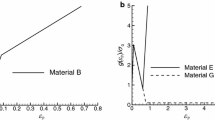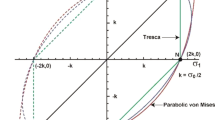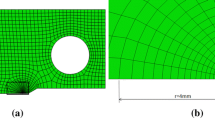Abstract
The dynamic effects on the near crack-line fields for steady-state tensile crack growth in an elastic perfectly-plastic solid are investigated under plane stress condition in this paper. In the plastic loading zone, the stresses and particle velocities near the crack-line are expanded in powers of the distance y to the crack line, with coefficients which depend on the distance of the moving crack tip. Substituting the expansions into the equations of motion, the Huber-Mises yield criterion and the Prandtl-Reuss flow rule yield a system of non-linear ordinary differential equations for the coefficients. This equation system is solved by using the approximate approach proposed by J.D. Achenbach and Z.L. Li. Finally, the crack growth criterion of critical strain is employed to determine the value of the remote elastic stress intensity factor K 1that would be required for a crack growing steadily at a given Mach number. It is also shown in this paper that the steady-state dynamic solution yields the quasi-static solution as the speed of crack growth tends to zero.
Résumé
On étude les effets dynamiques qu'exercent les champs de contrainte au voisinage de la ligne de fissuration sous des conditions de tension stable dans un solide parfaitement élastique-plastique et pour un état plan de tension.
Dans la zone de sollicitation plastique, les contraintes et vitesses élémentaires au voisinage de la ligne de fissuration se distribuent selon une puissance de la distance y à partir de cette ligne, avec des coefficients qui sont eux-mêmes dépendant de la distance à l'extrémité de la fissure en mouvement. En substituant les dilatations dans les équations de mouvement, le critère de plastification de Huber-Von Mises et la loi de'ecoulement de Prandtl-Reuss conduisent à un systéme d'équations différentielles ordinaires non linéaires pour déterminer ces coefficients.
On résoud ce système d'équations grâce à une approach proposée par J.D. Achenbach et Z.L. Li.
Enfin, le critère de déformation critique entraînant une croissance de la fissure est utilisé pour déterminer la valeur du facteur d'intensité des contraintes élastiques lointaines K 1qui serait requis pour qu'une fissure croisse régulièrement à un nombre de Mach donné. On montre également dans l'étude qu'une solution dynamique sous conditions stables conduit à une solution quasi-statique lorsque la vitesse de propagation de la fissure tend vers zéro.
Similar content being viewed by others
References
L.I. Slepyan, Nauk SSSR, Mekhanika Tverdogo Tela 12 (1976) 144–153.
J.D. Achenbach and V. Dunayevsky, Journal of Mechanics and Physics of Solids 29 (1981) 283–303.
Y.C. Gao and S. Nemat-Nasser, Mechanics of Materials 2 (1983) 47–60.
J.D. Achenbach and Z.L. Li, in Fundamentals of Deformation and Fracture, B.A. Bilby and K.J. Miller (eds.), Cambridge University Press (1985) 217–232.
J.D. Achenbach and V. Dunayevsky, Journal of Mechanics and Physics of Solids 32 (1984) 89–100.
J.D. Achenbach and Z.L. Li, Engineering Fracture Mechanics 20 (1984) 535–544.
Q.X. Guo and K.R. Li, in Proceedings of International Conference on Fracture and Fracture Mechanics, Shanghai (April 1987) 349–353.
F.A. McClintock and G.R. Irwin, in Fracture Toughness Testing and Its Applications, ASTM STP 381 (1965).
Z.L. Li, “Plastic Deformation on Crack Line in an Elastic Perfectly-Plastic Material”, Ph.D dissertation, Northwestern University (1985).
M. Creager and P.C. Paris, International Journal of Fracture Mechanics 3 (1967) 247–252.
J.D. Achenbach and Z.L. Li, Engineering Fracture Mechanics 22 (1985) 1073–1078.
Q.X. Guo and K.R. Li, Engineering Fracture Mechanics (accepted for publication).
Author information
Authors and Affiliations
Rights and permissions
About this article
Cite this article
Guo, Q., Li, Z. & Li, K. Dynamic effects on the near crack-line fields for crack growth in an elastic perfectly-plastic solid. Int J Fract 36, 71–81 (1988). https://doi.org/10.1007/BF00034818
Received:
Accepted:
Issue Date:
DOI: https://doi.org/10.1007/BF00034818




